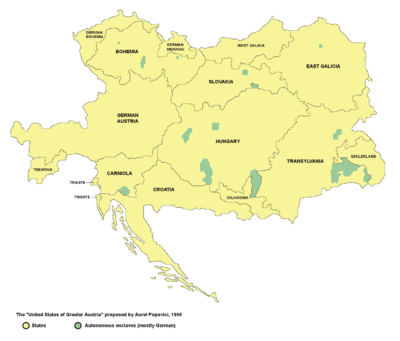United States of Greater Austria
This article relies largely or entirely on a single source. (January 2009) |
The United States of Greater Austria (German: Vereinigte Staaten von Groß-Österreich) was an idea created by a group of scholars surrounding the Austrian Archduke Franz Ferdinand that never came to pass. This specific proposal was conceived by Aurel Popovici in 1906.

As the twentieth century started to unfold, the greatest problem facing the dual monarchy of Austria-Hungary was that it consisted of eleven distinctly different ethnic groupings, of which only two, the Germans and Hungarians (who together accounted for about 44% of the total population), wielded any power or control. The other ten groupings (Czechs, Poles, Ruthenians, Romanians, Croatians, Slovaks, Bosniaks, Serbs, Slovenes and Italians) hardly wielded any power at all, only some Croats and Serbs had limited autonomy in the Kingdom of Croatia and Slavonia. The idea of the Dual Monarchy system of 1867 had been to split the previous Austrian Empire into two realms, one German-dominated, the other Hungarian-dominated. However, after various demonstrations, uprisings and acts of terrorism, it became readily apparent that the notion of two ethnic groups dominating the other nine could not realistically survive in perpetuam.
Franz Ferdinand had planned to radically redraw the map of Austria-Hungary, creating a number of ethnically and linguistically dominated semi-autonomous "states" which would all be part of a larger confederation renamed the United States of Greater Austria. Under this plan, language and cultural identification was encouraged, and the disproportionate balance of power would be corrected. The idea was set to encounter heavy opposition from the Hungarian part of the Dual Monarchy, since a direct result of the reform would have been a significant territorial loss for Hungary.
However, the Archduke was assassinated at Sarajevo in 1914, triggering the outbreak of the First World War, after which Austria-Hungary was dismantled and several new nation states were created, as well as various Austro-Hungarian territories ceded to existing neighbouring countries, by the victorious Entente powers.
Proposed states from Aurel Popovici

The idea came from Hungarian revolutionary Lajos Kossuth, who proposed to transform the Habsburg Empire into a so-called "Danubian State", a federal state with autonomous regions.[1][2] The following territories were supposed to become states of the federation after the reform. The majority ethnic group within each territory is also listed.

- Deutsch-Österreich (German-Austria, present-day Austria, the Italian province of South Tyrol, and the southern part of the present-day Czech Republic, ethnic German)
- Deutsch-Böhmen (German-Bohemia, northwestern part of present-day Czech Republic, ethnic German)
- Deutsch-Mähren (German-Moravia, northeastern part of present-day Czech Republic, ethnic German)
- Böhmen (Bohemia, southern and central part of present-day Czech Republic, ethnic Czech)
- Slowakenland (Slovakia, ethnic Slovak)
- West-Galizien (West Galicia, part of present-day Poland, ethnic Pole)
- Ost-Galizien (East Galicia, part of present-day Ukraine and Poland, ethnic Rusyn and Ukrainian)
- Ungarn (Hungary, present-day Hungary, southern Slovakia, northern Vojvodina, ethnic Magyar)
- Seklerland (Székely Land, part of present-day Romania, ethnic Magyar)
- Siebenbürgen (Transylvania, the Banat, plus Bukovina - part of present-day Romania and Ukraine, ethnic Romanian)
- Trento (Trentino, part of present-day Italy, ethnic Italian)
- Triest (Trieste and Gorizia, parts of present-day Italy, western Istria, part of present-day Croatia and Slovenia, ethnic Italian)
- Krain (Carniola, present-day Slovenia and southern Carinthia, ethnic Slovene)
- Kroatien (Croatia, Srem in present-day Serbia and Boka Kotorska in present-day Montenegro, ethnic Croatian and Serb)
- Woiwodina (Vojvodina, part of present-day Serbia, ethnic Serbian)
In addition, a number of mostly German-speaking enclaves in eastern Transylvania, the Banat and other parts of Hungary, southern Slovenia, large cities (such as Prague, Budapest, Lvov and others) and elsewhere were to have autonomy within the respective territory.
“The great origin, language, customs and mentality diversity of different nationalities requires, for the whole Empire of the Habsburgs, a certain state form, which can guarantee that not a single nationality will be threatened, obstructed or offended in its nationalpolitical life, in its private development, in its national pride, in one word – in its way of feeling and living”
Aurel Popovici (1906)
References
- Isac, Iulian Nicusor. The United States of Greater Austria – a step towards European Union? (PDF). Retrieved December 2009.
{{cite book}}: Check date values in:|accessdate=(help) - Template:De icon Kowalski, Erich (2005). Die Pläne zur Reichsreform der Militärkanzlei des Thronfolgers Franz Ferdinand im Spannungsfeld von Trialismus und Föderalismus. Vienna: Universitätsbibliothek Universität Wien.
{{cite book}}: Cite has empty unknown parameter:|1=(help) - Template:De icon Popovici, Aurel (1906). Die Vereinigten Staaten von Groß-Österreich. Politische Studien zur Lösung der nationalen Fragen und staatrechtlichen Krisen in Österreich-Ungarn. Leipzig.
{{cite book}}: CS1 maint: location missing publisher (link) - Template:De icon Teslaru-Born, Alina (2005). Ideen und Projekte zur Föderalisierung des Habsburgischen Reiches mit besonderer Berücksichtigung Siebenbürgens 1848–1918 (Inauguraldissertation) (PDF). Frankfurt am Main: Johann-Wolfgang-Goethe-Universität zu Frankfurt am Main. Retrieved December 2009.
{{cite book}}: Check date values in:|accessdate=(help)
